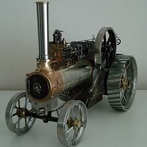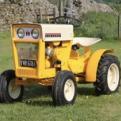-
Content Count
1,123 -
Joined
-
Last visited
-
Days Won
143
Reputation Activity
-
 Anglo Traction reacted to Stormin in A Mystery Roaring Twenties Refurb.......hopefully!
Anglo Traction reacted to Stormin in A Mystery Roaring Twenties Refurb.......hopefully!
I just looked at that photo again, Richard. I had a vision of you shaking the tank and dancing round the garden to the Konga tune.
-
 Anglo Traction reacted to mattblack in A Mystery Roaring Twenties Refurb.......hopefully!
Anglo Traction reacted to mattblack in A Mystery Roaring Twenties Refurb.......hopefully!
You sir, are the master of understatement
-
 Anglo Traction got a reaction from Alan in A Mystery Roaring Twenties Refurb.......hopefully!
Anglo Traction got a reaction from Alan in A Mystery Roaring Twenties Refurb.......hopefully!
Behind schedule with the Plummer Block (pillow) bearings, lots of cleaning out. Meanwhile, I looked at the frame items etc that were borderline scrap or broken.
Well , when you're presented with these examples, you wonder how you're going to replace them?, then try and repair-
The Eye Bolts look handmade or Smithy'd and what I would call Agricultural engineering, as opposed to Precision engineering.
The bolts were saved with careful work loosening off and straightening, plus, I was able to cut off the overlong rotted sections.
The channel formed washers on the small eye bolts were virtually rotted away, so I had to think about making replacements.
The problem with broken brass Butterfly wingnuts was solved by finding a stronger 1/4" whitworth steel one .
Making the special washers mentioned were shaped more or less using an old toolmaker's clamp and shown with a partially formed washer bottom right-
A bit of normalising heat and manipulating them to shape produced these washers that should pass as identical to original when fitted/painted-
Another job of saving scrap was the Clutch Lever. I'll post an image of what it was like later when the identity of the machine is revealed.
New pivot pin and cable pinch screw had to be made. The two clamp screws were rotten, and so I replaced them with nickel plated ones of the same age
that came from the drive unit of an old wind up gramophone.
Presumed the lever was nickel plated originally, but just coated with Caliper Paint now-
Should make better progress now and media blasting parts now available. Should be done with one of the shafts and bearings over the weekend......tbc
-
 Anglo Traction got a reaction from Cub Cadet in A Mystery Roaring Twenties Refurb.......hopefully!
Anglo Traction got a reaction from Cub Cadet in A Mystery Roaring Twenties Refurb.......hopefully!
Behind schedule with the Plummer Block (pillow) bearings, lots of cleaning out. Meanwhile, I looked at the frame items etc that were borderline scrap or broken.
Well , when you're presented with these examples, you wonder how you're going to replace them?, then try and repair-
The Eye Bolts look handmade or Smithy'd and what I would call Agricultural engineering, as opposed to Precision engineering.
The bolts were saved with careful work loosening off and straightening, plus, I was able to cut off the overlong rotted sections.
The channel formed washers on the small eye bolts were virtually rotted away, so I had to think about making replacements.
The problem with broken brass Butterfly wingnuts was solved by finding a stronger 1/4" whitworth steel one .
Making the special washers mentioned were shaped more or less using an old toolmaker's clamp and shown with a partially formed washer bottom right-
A bit of normalising heat and manipulating them to shape produced these washers that should pass as identical to original when fitted/painted-
Another job of saving scrap was the Clutch Lever. I'll post an image of what it was like later when the identity of the machine is revealed.
New pivot pin and cable pinch screw had to be made. The two clamp screws were rotten, and so I replaced them with nickel plated ones of the same age
that came from the drive unit of an old wind up gramophone.
Presumed the lever was nickel plated originally, but just coated with Caliper Paint now-
Should make better progress now and media blasting parts now available. Should be done with one of the shafts and bearings over the weekend......tbc
-
 Anglo Traction got a reaction from Stormin in A Mystery Roaring Twenties Refurb.......hopefully!
Anglo Traction got a reaction from Stormin in A Mystery Roaring Twenties Refurb.......hopefully!
Thanks Norm. I won't keep the mystery for too long now, as I will need to start on the frame etc soon. I'm sure some visitors/Members will know what it is.
Cyril Grange's book was a significant reference for many years. first published in 1929 and the ninth edition in 1954 (mine's the latter). I have the 2nd edition (I think) as an 'E' book which revealed the clutch info.
Brief update-
Working through the power unit and associated parts, I started checking out the Fuel Tank. An irreplaceable item for this machine, so I was pleased to find it bone dry inside. A thin layer of dried up petrified fuel/oil was able to be scratched away from the inner surface. I went to my 'Scope on a Rope' to check it out. Images are not great quality as copies, but gave me a good view-
So I started to check the outside soldered joints and the level of rust penetration to ensure no perforations-
Nothing that can't be put right cosmetically and with only 2 small/shallow dents in one end and the dents/marks where it is fixed to the frame.
Only thing to repair is the outlet boss, where the Tap/filter must have been hit at some time and bent/cracked the old lead soldered joint-
Tinned Steel plate is not very thick, but certainly the plating helped keep the bad rust at bay and happy with the initial external clean up-
So started on inside using pea sized shingle dry to start with and does it well -
Will do several more 'shakes' with this, then when I've sealed and repaired the external bits, I'll change to fluids with the shingle and a final washout.
The tank is 1/2 imperial gallon (2.27 ltrs). Fuel pipe is 1/4" copper pipe which I will need to replace (to save repairs and cleaning)......tbc
-
 Anglo Traction reacted to Cub Cadet in A Mystery Roaring Twenties Refurb.......hopefully!
Anglo Traction reacted to Cub Cadet in A Mystery Roaring Twenties Refurb.......hopefully!
Looking great!
-
 Anglo Traction got a reaction from Cub Cadet in C-125 Rebuild.
Anglo Traction got a reaction from Cub Cadet in C-125 Rebuild.
+1 for skinny rims. I'm lucky as I have both wide and narrow WH wheels for the 72 Raider now. The track width on the front with the 6.50's fitted is 2 inches (51mm -ish) less than post 75 WHs.
Nice work Norm look's tidy . Are you going to 'Sticker' it up , or leave it naked ?.
-
 Anglo Traction got a reaction from HeadExam in C-125 Rebuild.
Anglo Traction got a reaction from HeadExam in C-125 Rebuild.
+1 for skinny rims. I'm lucky as I have both wide and narrow WH wheels for the 72 Raider now. The track width on the front with the 6.50's fitted is 2 inches (51mm -ish) less than post 75 WHs.
Nice work Norm look's tidy . Are you going to 'Sticker' it up , or leave it naked ?.
-
 Anglo Traction got a reaction from Stormin in C-125 Rebuild.
Anglo Traction got a reaction from Stormin in C-125 Rebuild.
+1 for skinny rims. I'm lucky as I have both wide and narrow WH wheels for the 72 Raider now. The track width on the front with the 6.50's fitted is 2 inches (51mm -ish) less than post 75 WHs.
Nice work Norm look's tidy . Are you going to 'Sticker' it up , or leave it naked ?.
-
 Anglo Traction reacted to Stormin in C-125 Rebuild.
Anglo Traction reacted to Stormin in C-125 Rebuild.
Got another day in the workshop. Sorted and replaced the bonnet. All that's left now are the tach-o-matics to paint and fit. Touch up some bits of paint work and order graphics.
Another exhaust will be made later. May not be a stack though.
That's it. Horse ready to be put back into harness.
-
 Anglo Traction got a reaction from Stormin in A Mystery Roaring Twenties Refurb.......hopefully!
Anglo Traction got a reaction from Stormin in A Mystery Roaring Twenties Refurb.......hopefully!
Brief update. Wasn't happy that the outlet bushing in the tank would solder properly, so I removed it to clean it up and re solder it-
Prepped and painted a few parts, tank and straps finished. A lot of work involved to reach this stage.
Also one of the control levers finished, where I had to make a new limit strap and rivets, as it was too rusted (see 3rd pic in post #13) -
.
Tank and straps have had a coat of fuel proof lacquer to protect it and I'll give it a final 'shake up' with stones, kerosene/redex to swill the residues out.
I've got 2 tank lids, one original and one a few years younger with it's own measure for the correct oil to petrol ratio !.
Fuel line will be done near the frame completion stage.
Shaft bearings next and look's like I'll have to make several fixings including 'Butterfly' Wingnuts as several of the originals have had the wings broken off, now unobtainable.
tbc
-
 Anglo Traction got a reaction from Cub Cadet in A Mystery Roaring Twenties Refurb.......hopefully!
Anglo Traction got a reaction from Cub Cadet in A Mystery Roaring Twenties Refurb.......hopefully!
Brief update. Wasn't happy that the outlet bushing in the tank would solder properly, so I removed it to clean it up and re solder it-
Prepped and painted a few parts, tank and straps finished. A lot of work involved to reach this stage.
Also one of the control levers finished, where I had to make a new limit strap and rivets, as it was too rusted (see 3rd pic in post #13) -
.
Tank and straps have had a coat of fuel proof lacquer to protect it and I'll give it a final 'shake up' with stones, kerosene/redex to swill the residues out.
I've got 2 tank lids, one original and one a few years younger with it's own measure for the correct oil to petrol ratio !.
Fuel line will be done near the frame completion stage.
Shaft bearings next and look's like I'll have to make several fixings including 'Butterfly' Wingnuts as several of the originals have had the wings broken off, now unobtainable.
tbc
-
 Anglo Traction got a reaction from Cub Cadet in A Mystery Roaring Twenties Refurb.......hopefully!
Anglo Traction got a reaction from Cub Cadet in A Mystery Roaring Twenties Refurb.......hopefully!
Thanks Norm. I won't keep the mystery for too long now, as I will need to start on the frame etc soon. I'm sure some visitors/Members will know what it is.
Cyril Grange's book was a significant reference for many years. first published in 1929 and the ninth edition in 1954 (mine's the latter). I have the 2nd edition (I think) as an 'E' book which revealed the clutch info.
Brief update-
Working through the power unit and associated parts, I started checking out the Fuel Tank. An irreplaceable item for this machine, so I was pleased to find it bone dry inside. A thin layer of dried up petrified fuel/oil was able to be scratched away from the inner surface. I went to my 'Scope on a Rope' to check it out. Images are not great quality as copies, but gave me a good view-
So I started to check the outside soldered joints and the level of rust penetration to ensure no perforations-
Nothing that can't be put right cosmetically and with only 2 small/shallow dents in one end and the dents/marks where it is fixed to the frame.
Only thing to repair is the outlet boss, where the Tap/filter must have been hit at some time and bent/cracked the old lead soldered joint-
Tinned Steel plate is not very thick, but certainly the plating helped keep the bad rust at bay and happy with the initial external clean up-
So started on inside using pea sized shingle dry to start with and does it well -
Will do several more 'shakes' with this, then when I've sealed and repaired the external bits, I'll change to fluids with the shingle and a final washout.
The tank is 1/2 imperial gallon (2.27 ltrs). Fuel pipe is 1/4" copper pipe which I will need to replace (to save repairs and cleaning)......tbc
-
 Anglo Traction got a reaction from nigel in A Mystery Roaring Twenties Refurb.......hopefully!
Anglo Traction got a reaction from nigel in A Mystery Roaring Twenties Refurb.......hopefully!
Brief update. Wasn't happy that the outlet bushing in the tank would solder properly, so I removed it to clean it up and re solder it-
Prepped and painted a few parts, tank and straps finished. A lot of work involved to reach this stage.
Also one of the control levers finished, where I had to make a new limit strap and rivets, as it was too rusted (see 3rd pic in post #13) -
.
Tank and straps have had a coat of fuel proof lacquer to protect it and I'll give it a final 'shake up' with stones, kerosene/redex to swill the residues out.
I've got 2 tank lids, one original and one a few years younger with it's own measure for the correct oil to petrol ratio !.
Fuel line will be done near the frame completion stage.
Shaft bearings next and look's like I'll have to make several fixings including 'Butterfly' Wingnuts as several of the originals have had the wings broken off, now unobtainable.
tbc
-
 Anglo Traction got a reaction from Alan in A Mystery Roaring Twenties Refurb.......hopefully!
Anglo Traction got a reaction from Alan in A Mystery Roaring Twenties Refurb.......hopefully!
Brief update. Wasn't happy that the outlet bushing in the tank would solder properly, so I removed it to clean it up and re solder it-
Prepped and painted a few parts, tank and straps finished. A lot of work involved to reach this stage.
Also one of the control levers finished, where I had to make a new limit strap and rivets, as it was too rusted (see 3rd pic in post #13) -
.
Tank and straps have had a coat of fuel proof lacquer to protect it and I'll give it a final 'shake up' with stones, kerosene/redex to swill the residues out.
I've got 2 tank lids, one original and one a few years younger with it's own measure for the correct oil to petrol ratio !.
Fuel line will be done near the frame completion stage.
Shaft bearings next and look's like I'll have to make several fixings including 'Butterfly' Wingnuts as several of the originals have had the wings broken off, now unobtainable.
tbc
-
 Anglo Traction reacted to Alan in A Mystery Roaring Twenties Refurb.......hopefully!
Anglo Traction reacted to Alan in A Mystery Roaring Twenties Refurb.......hopefully!
Ditto Norm. What is it. ? Has to be another masterpiece of some sort.
-
 Anglo Traction got a reaction from nigel in A Mystery Roaring Twenties Refurb.......hopefully!
Anglo Traction got a reaction from nigel in A Mystery Roaring Twenties Refurb.......hopefully!
Thanks Norm. I won't keep the mystery for too long now, as I will need to start on the frame etc soon. I'm sure some visitors/Members will know what it is.
Cyril Grange's book was a significant reference for many years. first published in 1929 and the ninth edition in 1954 (mine's the latter). I have the 2nd edition (I think) as an 'E' book which revealed the clutch info.
Brief update-
Working through the power unit and associated parts, I started checking out the Fuel Tank. An irreplaceable item for this machine, so I was pleased to find it bone dry inside. A thin layer of dried up petrified fuel/oil was able to be scratched away from the inner surface. I went to my 'Scope on a Rope' to check it out. Images are not great quality as copies, but gave me a good view-
So I started to check the outside soldered joints and the level of rust penetration to ensure no perforations-
Nothing that can't be put right cosmetically and with only 2 small/shallow dents in one end and the dents/marks where it is fixed to the frame.
Only thing to repair is the outlet boss, where the Tap/filter must have been hit at some time and bent/cracked the old lead soldered joint-
Tinned Steel plate is not very thick, but certainly the plating helped keep the bad rust at bay and happy with the initial external clean up-
So started on inside using pea sized shingle dry to start with and does it well -
Will do several more 'shakes' with this, then when I've sealed and repaired the external bits, I'll change to fluids with the shingle and a final washout.
The tank is 1/2 imperial gallon (2.27 ltrs). Fuel pipe is 1/4" copper pipe which I will need to replace (to save repairs and cleaning)......tbc
-
 Anglo Traction got a reaction from Alan in A Mystery Roaring Twenties Refurb.......hopefully!
Anglo Traction got a reaction from Alan in A Mystery Roaring Twenties Refurb.......hopefully!
Thanks Norm. I won't keep the mystery for too long now, as I will need to start on the frame etc soon. I'm sure some visitors/Members will know what it is.
Cyril Grange's book was a significant reference for many years. first published in 1929 and the ninth edition in 1954 (mine's the latter). I have the 2nd edition (I think) as an 'E' book which revealed the clutch info.
Brief update-
Working through the power unit and associated parts, I started checking out the Fuel Tank. An irreplaceable item for this machine, so I was pleased to find it bone dry inside. A thin layer of dried up petrified fuel/oil was able to be scratched away from the inner surface. I went to my 'Scope on a Rope' to check it out. Images are not great quality as copies, but gave me a good view-
So I started to check the outside soldered joints and the level of rust penetration to ensure no perforations-
Nothing that can't be put right cosmetically and with only 2 small/shallow dents in one end and the dents/marks where it is fixed to the frame.
Only thing to repair is the outlet boss, where the Tap/filter must have been hit at some time and bent/cracked the old lead soldered joint-
Tinned Steel plate is not very thick, but certainly the plating helped keep the bad rust at bay and happy with the initial external clean up-
So started on inside using pea sized shingle dry to start with and does it well -
Will do several more 'shakes' with this, then when I've sealed and repaired the external bits, I'll change to fluids with the shingle and a final washout.
The tank is 1/2 imperial gallon (2.27 ltrs). Fuel pipe is 1/4" copper pipe which I will need to replace (to save repairs and cleaning)......tbc
-
 Anglo Traction got a reaction from nigel in A Mystery Roaring Twenties Refurb.......hopefully!
Anglo Traction got a reaction from nigel in A Mystery Roaring Twenties Refurb.......hopefully!
I was surprised it is still a significantly popular material, primarily due to it's durable stability.
Having shoved the engine to the back of the bench with a lightly cleaned Flywheel cover fitted after tapping out a few dents-
I moved on to tackling the Clutch. This is the very first Villiers version of a unit that fitted directly onto the output side of the crankshaft.
It was called the 'Villiers Free Engine Clutch' designed to allow Motor bicycles to be push started (no kick starts then) and then draw in the clutch to allow the rider to bring the machine to a halt and mount before pulling away smoothly/coming to a halt with the engine still running.
I had a real challenge finding anything on this unit until I found a sectional image of it, but with no nomenclature-
It was a start, but I had much trepidation about attempting to dismantle it without at least some info. I found only a brief reference to it in the books I had.
After much searching, I actually found where the above pic was taken from.
Some guy had taken it from an earlier publication (1st or 2nd edition) of 'The book of the Villiers Engine' by Cyril Grange .
It described the whole thing, operation, dismantling and assembly in detail .
Obsolete since the early 30s, I was on a 'no hoper' with spares.
So I set to and began stripping it out. Major job trying apply forces to undo the Bell cover (N) despite having Knurling to show it was only hand tightened.
Tried to release spring pressure on the plates by adjusting the cable tension, but overdid it and the cable pulled out of the aged nipple inside.
Succeeded with same process as the Flywheel removal and used 'Sisal rope' with a tourniquet and injected some oil where upon all came apart.
Multi layers of alternate steel and Bronze plates transfer the drive loads (7 of each) some are damaged and broken (not clear how?) -
All removed and retained in their respective positions for cleaning and inspection, so they all go back the same way.
A broken and bent plate was clearly put back and used like it, as wear is visible. Lot of work to make new ones, so will flatten and repair them as needed-
Bronze plates are the 'Drivers' and steel ones are 'Driven'. I had dearly wanted to strip the Counter shaft completely,
but it is impossible to release the Clutch body and it's retaining nut from the tapered end of the shaft-
So I am having to work around the assembled shaft parts in situ for now. Maybe when/if it has been run for a while, it may ease up?.
Cleaned all the constituent parts and quite impressed with the design. Felt Oil seal is rotted where the cable lead out exits, but will try and insert a new one-
Cable adjuster spanner flats are rusted to nearly round, so made a new one with lock nut-
Aged it by oil staining and roughing it up with a few burrs
Confident I can get this bit working as it should, so onto the next bits
-
 Anglo Traction got a reaction from Alan in A Mystery Roaring Twenties Refurb.......hopefully!
Anglo Traction got a reaction from Alan in A Mystery Roaring Twenties Refurb.......hopefully!
I was surprised it is still a significantly popular material, primarily due to it's durable stability.
Having shoved the engine to the back of the bench with a lightly cleaned Flywheel cover fitted after tapping out a few dents-
I moved on to tackling the Clutch. This is the very first Villiers version of a unit that fitted directly onto the output side of the crankshaft.
It was called the 'Villiers Free Engine Clutch' designed to allow Motor bicycles to be push started (no kick starts then) and then draw in the clutch to allow the rider to bring the machine to a halt and mount before pulling away smoothly/coming to a halt with the engine still running.
I had a real challenge finding anything on this unit until I found a sectional image of it, but with no nomenclature-
It was a start, but I had much trepidation about attempting to dismantle it without at least some info. I found only a brief reference to it in the books I had.
After much searching, I actually found where the above pic was taken from.
Some guy had taken it from an earlier publication (1st or 2nd edition) of 'The book of the Villiers Engine' by Cyril Grange .
It described the whole thing, operation, dismantling and assembly in detail .
Obsolete since the early 30s, I was on a 'no hoper' with spares.
So I set to and began stripping it out. Major job trying apply forces to undo the Bell cover (N) despite having Knurling to show it was only hand tightened.
Tried to release spring pressure on the plates by adjusting the cable tension, but overdid it and the cable pulled out of the aged nipple inside.
Succeeded with same process as the Flywheel removal and used 'Sisal rope' with a tourniquet and injected some oil where upon all came apart.
Multi layers of alternate steel and Bronze plates transfer the drive loads (7 of each) some are damaged and broken (not clear how?) -
All removed and retained in their respective positions for cleaning and inspection, so they all go back the same way.
A broken and bent plate was clearly put back and used like it, as wear is visible. Lot of work to make new ones, so will flatten and repair them as needed-
Bronze plates are the 'Drivers' and steel ones are 'Driven'. I had dearly wanted to strip the Counter shaft completely,
but it is impossible to release the Clutch body and it's retaining nut from the tapered end of the shaft-
So I am having to work around the assembled shaft parts in situ for now. Maybe when/if it has been run for a while, it may ease up?.
Cleaned all the constituent parts and quite impressed with the design. Felt Oil seal is rotted where the cable lead out exits, but will try and insert a new one-
Cable adjuster spanner flats are rusted to nearly round, so made a new one with lock nut-
Aged it by oil staining and roughing it up with a few burrs
Confident I can get this bit working as it should, so onto the next bits
-
 Anglo Traction got a reaction from Cub Cadet in A Mystery Roaring Twenties Refurb.......hopefully!
Anglo Traction got a reaction from Cub Cadet in A Mystery Roaring Twenties Refurb.......hopefully!
I was surprised it is still a significantly popular material, primarily due to it's durable stability.
Having shoved the engine to the back of the bench with a lightly cleaned Flywheel cover fitted after tapping out a few dents-
I moved on to tackling the Clutch. This is the very first Villiers version of a unit that fitted directly onto the output side of the crankshaft.
It was called the 'Villiers Free Engine Clutch' designed to allow Motor bicycles to be push started (no kick starts then) and then draw in the clutch to allow the rider to bring the machine to a halt and mount before pulling away smoothly/coming to a halt with the engine still running.
I had a real challenge finding anything on this unit until I found a sectional image of it, but with no nomenclature-
It was a start, but I had much trepidation about attempting to dismantle it without at least some info. I found only a brief reference to it in the books I had.
After much searching, I actually found where the above pic was taken from.
Some guy had taken it from an earlier publication (1st or 2nd edition) of 'The book of the Villiers Engine' by Cyril Grange .
It described the whole thing, operation, dismantling and assembly in detail .
Obsolete since the early 30s, I was on a 'no hoper' with spares.
So I set to and began stripping it out. Major job trying apply forces to undo the Bell cover (N) despite having Knurling to show it was only hand tightened.
Tried to release spring pressure on the plates by adjusting the cable tension, but overdid it and the cable pulled out of the aged nipple inside.
Succeeded with same process as the Flywheel removal and used 'Sisal rope' with a tourniquet and injected some oil where upon all came apart.
Multi layers of alternate steel and Bronze plates transfer the drive loads (7 of each) some are damaged and broken (not clear how?) -
All removed and retained in their respective positions for cleaning and inspection, so they all go back the same way.
A broken and bent plate was clearly put back and used like it, as wear is visible. Lot of work to make new ones, so will flatten and repair them as needed-
Bronze plates are the 'Drivers' and steel ones are 'Driven'. I had dearly wanted to strip the Counter shaft completely,
but it is impossible to release the Clutch body and it's retaining nut from the tapered end of the shaft-
So I am having to work around the assembled shaft parts in situ for now. Maybe when/if it has been run for a while, it may ease up?.
Cleaned all the constituent parts and quite impressed with the design. Felt Oil seal is rotted where the cable lead out exits, but will try and insert a new one-
Cable adjuster spanner flats are rusted to nearly round, so made a new one with lock nut-
Aged it by oil staining and roughing it up with a few burrs
Confident I can get this bit working as it should, so onto the next bits
-
 Anglo Traction got a reaction from Stormin in A Mystery Roaring Twenties Refurb.......hopefully!
Anglo Traction got a reaction from Stormin in A Mystery Roaring Twenties Refurb.......hopefully!
I was surprised it is still a significantly popular material, primarily due to it's durable stability.
Having shoved the engine to the back of the bench with a lightly cleaned Flywheel cover fitted after tapping out a few dents-
I moved on to tackling the Clutch. This is the very first Villiers version of a unit that fitted directly onto the output side of the crankshaft.
It was called the 'Villiers Free Engine Clutch' designed to allow Motor bicycles to be push started (no kick starts then) and then draw in the clutch to allow the rider to bring the machine to a halt and mount before pulling away smoothly/coming to a halt with the engine still running.
I had a real challenge finding anything on this unit until I found a sectional image of it, but with no nomenclature-
It was a start, but I had much trepidation about attempting to dismantle it without at least some info. I found only a brief reference to it in the books I had.
After much searching, I actually found where the above pic was taken from.
Some guy had taken it from an earlier publication (1st or 2nd edition) of 'The book of the Villiers Engine' by Cyril Grange .
It described the whole thing, operation, dismantling and assembly in detail .
Obsolete since the early 30s, I was on a 'no hoper' with spares.
So I set to and began stripping it out. Major job trying apply forces to undo the Bell cover (N) despite having Knurling to show it was only hand tightened.
Tried to release spring pressure on the plates by adjusting the cable tension, but overdid it and the cable pulled out of the aged nipple inside.
Succeeded with same process as the Flywheel removal and used 'Sisal rope' with a tourniquet and injected some oil where upon all came apart.
Multi layers of alternate steel and Bronze plates transfer the drive loads (7 of each) some are damaged and broken (not clear how?) -
All removed and retained in their respective positions for cleaning and inspection, so they all go back the same way.
A broken and bent plate was clearly put back and used like it, as wear is visible. Lot of work to make new ones, so will flatten and repair them as needed-
Bronze plates are the 'Drivers' and steel ones are 'Driven'. I had dearly wanted to strip the Counter shaft completely,
but it is impossible to release the Clutch body and it's retaining nut from the tapered end of the shaft-
So I am having to work around the assembled shaft parts in situ for now. Maybe when/if it has been run for a while, it may ease up?.
Cleaned all the constituent parts and quite impressed with the design. Felt Oil seal is rotted where the cable lead out exits, but will try and insert a new one-
Cable adjuster spanner flats are rusted to nearly round, so made a new one with lock nut-
Aged it by oil staining and roughing it up with a few burrs
Confident I can get this bit working as it should, so onto the next bits
-
 Anglo Traction got a reaction from HeadExam in Another Chainsaw Restoration
Anglo Traction got a reaction from HeadExam in Another Chainsaw Restoration
Sorry Alain, I missed this one. Good looking machine after what you have done to it. The decal orientation does not affect it's appearance. Will it see/make some sawdust?.
-
 Anglo Traction got a reaction from Stormin in BSA Power unit
Anglo Traction got a reaction from Stormin in BSA Power unit
JimStDavids, If you click (or hover the cursor) on Paul's name on the left of his post, it will open another window and give you the opportunity to send him a personal message.
If he has enabled this in his settings, it will give him a notice of your mssge in his Email inbox and prompt him to visit this forum again .
-
 Anglo Traction got a reaction from JimStDavids in BSA Power unit
Anglo Traction got a reaction from JimStDavids in BSA Power unit
JimStDavids, If you click (or hover the cursor) on Paul's name on the left of his post, it will open another window and give you the opportunity to send him a personal message.
If he has enabled this in his settings, it will give him a notice of your mssge in his Email inbox and prompt him to visit this forum again .







